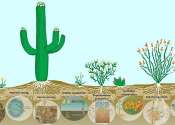Fertilizer (or fertiliser) is any organic or inorganic material of natural or synthetic origin (other than liming materials) that is added to a soil to supply one or more plant nutrients essential to the growth of plants. A recent assessment found that about 40 to 60% of crop yields are attributable to commercial fertilizer use.
Mined inorganic fertilizers have been used for many centuries, whereas chemically synthesized inorganic fertilizers were only widely developed during the industrial revolution. Increased understanding and use of fertilizers were important parts of the pre-industrial British Agricultural Revolution and the industrial Green Revolution of the 20th century.
Inorganic fertilizer use has also significantly supported global population growth — it has been estimated that almost half the people on the Earth are currently fed as a result of synthetic nitrogen fertilizer use.
Fertilizers typically provide, in varying proportions:
The macronutrients are consumed in larger quantities and are present in plant tissue in quantities from 0.15% to 6.0% on a dry matter (0% moisture) basis (DM). Micronutrients are consumed in smaller quantities and are present in plant tissue on the order of parts per million (ppm), ranging from 0.15 to 400 ppm DM, or less than 0.04% DM.
Only three other macronutrients are required by all plants: carbon, hydrogen, and oxygen. These nutrients are supplied by water and carbon dioxide.
The nitrogen-rich fertilizer ammonium nitrate is also used as an oxidizing agent in improvised explosive devices, sometimes called fertilizer bombs, leading to sale regulations[citation needed].









